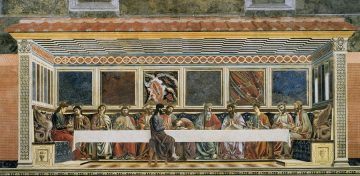Jerry Saltz at New York Magazine:
 This isn’t a style of the Church, Italy, a patron, or a doctrine. It’s a personal style, the work of a self-taught 40-something gay man who devised ways to dye one’s hair blond as well as build bridges. Art history has been going through regular stylistic shifts ever since. This is what a social revolution looks like.
This isn’t a style of the Church, Italy, a patron, or a doctrine. It’s a personal style, the work of a self-taught 40-something gay man who devised ways to dye one’s hair blond as well as build bridges. Art history has been going through regular stylistic shifts ever since. This is what a social revolution looks like.
This brings us to Castagno’s marvelous Last Supper, a Middle Renaissance masterpiece. This huge beauty covers one wall in the Florence refectory of the Benedictine nuns of Saint Apollonia. The space isn’t rhythmic, cinematic, naturalistic, breathing, or real. It’s a wildly exciting mix of Byzantine with forced geometric perspective, exaggerated horizontality, metaphysical symbolism, finicky late medievalism, spiritualism, and episodic herky-jerkiness. It shows us what Last Suppers used to look like: Each disciple might be given particular attributes to universalize them and make them recognizable; they might hold certain objects, follow established iconographic or pictorial programs, pose in specific ways.
more here.
